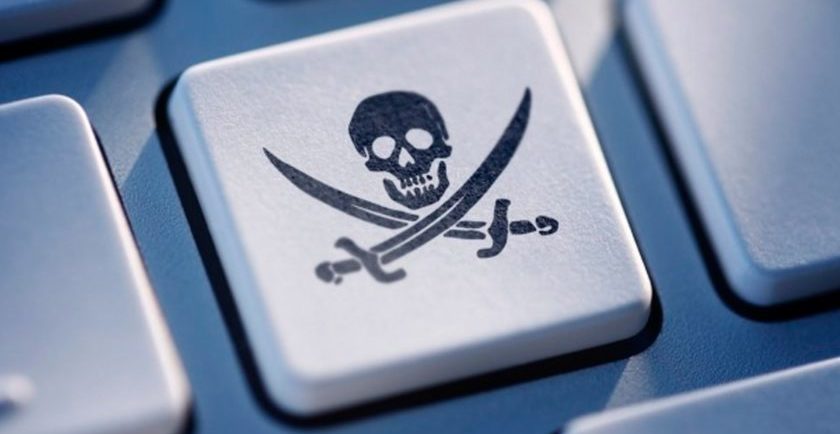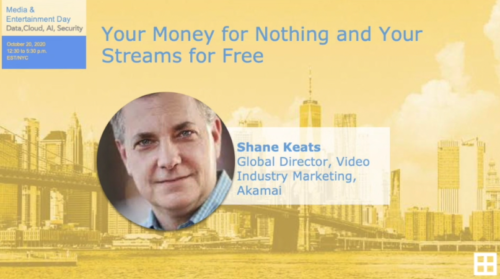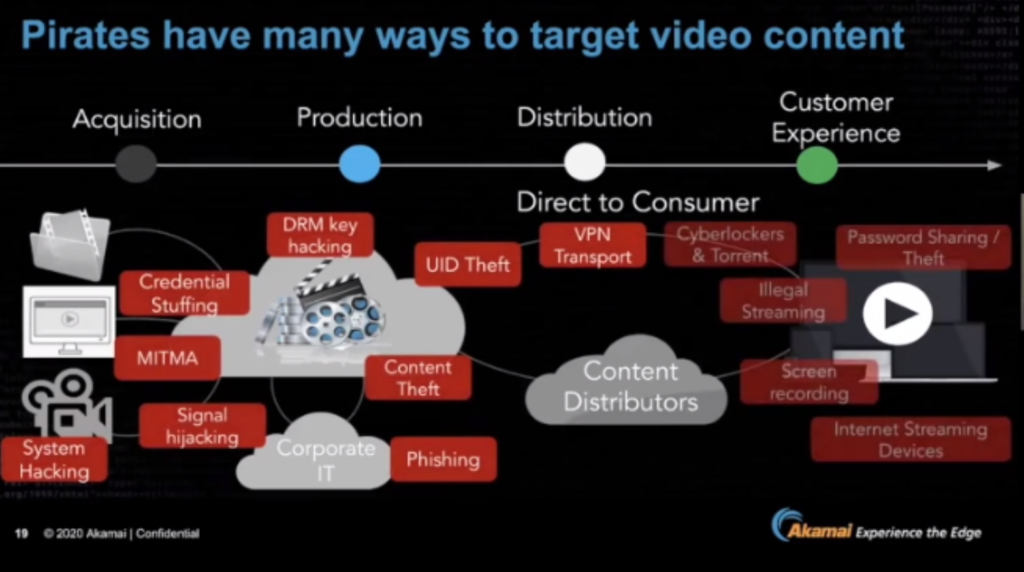
Akamai: It Pays to Combat Piracy
Although it may be tempting to question whether it pays for companies to combat the age-old problem of content piracy, recent studies indicate that the answer tends to be yes, according to Shane Keats, global director of video industry marketing at Akamai.
“Piracy of the moving image has been with our industry since the silent movie age,” he said Oct. 20 during the online Media &; Entertainment Day event.
“It was called ‘bicycling’ back then and theaters that hadn’t paid for the latest Mary Pickford or Errol Flynn picture could slip a few bucks to the projectionist, who would ‘bicycle’ the film cannisters to his theater,” he noted during the Anti-Piracy & Streaming breakout session “Your Money for Nothing and Your Streams for Free.”
“But piracy as we know it started to come into its own with the invention of the VHS cassette tape and easy duplication” many years later, he told viewers, recalling: “A long time ago… when I was a teenager, I spent my years in lower Manhattan. And, if you want to buy a knockoff Gucci or a pair of Ray-Bans, you go to Canal Street. And, in the mid-1980s, when I was growing up, it was also where you went to buy an illegal dupe of Daryl Hannah in ‘Splash’ for a couple of bucks.”
Today, however, “piracy is a lot more sophisticated and its costs our industry a hell of a lot more” than it did back then, he noted, but conceded: “How much more no one really knows. It could be $30 billion. It could be $50 billion. Maybe $60 billion… It’s just a hard thing to measure. Do you count, for example, jobs lost to piracy?”
The producer Martha De Laurentiis claimed the TV show “Hannibal” was canceled after its third season because of piracy, although NBC attributed the cancellation to low ratings, Keats said. But “it’s possible that both things could be true” because it was one of the five most pirated shows at places like The Pirate Bay that year, he noted.
“We do have a better idea just how much money pirates make because we have tools that can estimate usage, and any kind of casual tour of dark web marketplaces gives us a decent range of price points for things like a fully loaded Kodi service or a validated Netflix credential,” he pointed out.
 The European Union’s intellectual property office did a study in which it found 13.7 million people had accessed copyright-infringing IPTV providers, he said, noting that works out to 5.73 euros per user per month.
The European Union’s intellectual property office did a study in which it found 13.7 million people had accessed copyright-infringing IPTV providers, he said, noting that works out to 5.73 euros per user per month.
With that kind of average revenue per user (ARPU) – and “let’s be candid with each other, a pretty low cost of content – pirates here are incented to innovate,” he said. “So we have to ask ourselves whether it’s even worth it to fight back given how hard they’re going to fight for our content,” he conceded.
However, recent evidence shows that “the answer is an unequivocal yes,” he said.
Noting that Southeast Asia is known as “the place where there is the greatest piracy participation among viewers,” he said video services and rights owners last year “started to put pressure on the Malaysian government to take action.” And the Malaysian government “apparently did a decent job in this crackdown,” he noted.
After all, Asia’s equivalent of the Motion Picture Association – the Asia Video Industry Association – commissioned YouGov to do a before-and-after study, which found that viewership of pirated content fell 64 percent year over year and 49 percent of former pirate viewers no longer were accessing pirated material, he said.
Among the other findings: In August 2019, 61% viewed pirated content, but in August 2020, that tumbled to 22% who viewed pirated content, according to Akamai.
If you represent a streaming service, you might want to calculate whether it is worth it to invest in the security protection you need, Keats said. Among the questions to ask in order to reach a conclusion, he noted, is: Will I make back the $100,000 I may have spent on investments to fight piracy either via increased revenue or reduced cost? Now, pretend you have a magic wand that can make it impossible to pirate your content and ask: Would every viewer who watched your service illegally suddenly pay to do so?
In building a business case to justify spending money to fight piracy, he suggested that an organization factor in:
- Whether the content is new, first-run content or library content, which tends to be cheaper.
- Are your viewers younger or older? Richer or poorer? Are they tech savvy?
- What else is available for the viewer’s time?
- What is the cost of doing nothing?
- How big is the problem?
Citing the results of an Akamai study based on a dataset of 12 U.S.-based over-the-top streaming service providers, viewers from 168 countries and 561,784 hours of streaming, Keats said 7.7% of IPs were associated with piracy and there were 392 unique piracy providers.
 Meanwhile, a Sandvine study found that as much as 50% of “Game of Thrones” traffic was being viewed on pirated services, he noted.
Meanwhile, a Sandvine study found that as much as 50% of “Game of Thrones” traffic was being viewed on pirated services, he noted.
An anti-piracy profit and loss analysis shows there’s “some real potential benefits to your company,” he said, including: More recurring revenue, better lifetime customer value, reduced account resets, fewer credit card chargebacks and less brand damage.
“All in all, better economics and the academic data supports this,” he said, pointing to three studies that found: Digital revenue for studios increased 6.5-8.5% by fighting piracy; there was a 6% increase to sites like Netflix and a 10% increase to ad-supported sites like BBC and Channel 5 by fighting piracy; and once a consumer finds out how to pirate, he or she is less likely to make purchases in the future.
Pirates have many ways to target video content and Akamai has lots of solutions to combat piracy, according to Keats.
“You don’t want to end up like Bundesliga,” he warned, referring to the German pro soccer league. “They just lost their license in the Middle East because they weren’t protecting their content well enough and [a] Mideast pay TV broadcaster was unwilling to spend money to give money to Bundesliga because their content was being pirated so much.”
Click here to access the full presentation.
M&E Day was sponsored by IBM Security, Microsoft Azure, SHIFT, Akamai, Cartesian, Chesapeake Systems, ContentArmor, Convergent Risks, Deluxe, Digital Nirvana, edgescan, EIDR, PK, Richey May Technology Solutions, STEGA, Synamedia and Signiant and was produced by MESA, in cooperation with NAB Show New York, and in association with the Content Delivery & Security Association (CDSA) and the Hollywood IT Society (HITS).
